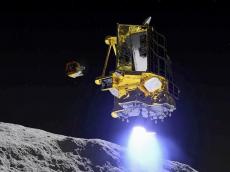|
|
TODAY.AZ / World news
Japan's Lunar Sniper probe lands on Moon but suffers power problems
20 January 2024 [23:33] - TODAY.AZ

The nation's robotic SLIM spacecraft touched down on the lunar surface this morning (Jan. 19), notching a huge success for Japan: It's just the fifth nation to land softly on Earth's nearest neighbor, Azernews reprots, citing space.com.
"First and foremost, landing was successful," Yamakawa Hiroshi, president of the Japan Aerospace Exploration Agency (JAXA), said during a post-landing press conference today (in Japanese; English translation provided by a translator during the briefing).
Going forward, "we should be able to access the lunar surface," Hiroshi added. "I believe that there is a path opening to that now."
The other countries in the moon-landing club are the Soviet Union and the United States, which made their first trips to the lunar surface during the Cold War space race; China, whose initial landing occurred in December 2013; and India, whose Chandrayaan-3 lander-rover duo touched down last August.
But it wasn't all good news for SLIM: The probe's solar panels aren't generating electricity as planned on the lunar surface, JAXA officials said during today's briefing. If the problem isn't fixed soon, SLIM could go forever silent. Its battery can support operations on the moon for just a few hours.
SLIM (short for "Smart Lander for Investigating Moon") launched last September, along with an X-ray space telescope called XRISM. The scope deployed into low Earth orbit shortly after liftoff (and recently sent home its first test images), but SLIM set out for more distant celestial shores.
The probe took a long and looping route toward the moon, finally arriving in lunar orbit on Christmas Day. Its initial orbit was highly elliptical, taking SLIM within 373 miles (600 kilometers) of the lunar surface at its closest point and 2,485 miles (4,000 km) away at its most distant.
Early on Sunday morning (Jan. 14), SLIM performed a crucial engine burn, circularizing its orbit at the 373-mile altitude and setting the stage for descent-and-landing operations.
Those operations ramped up with another burn this morning, which took SLIM's orbit down to about 9 miles (15 km) above the lunar surface. And they culminated in the landing try, which began today at about 10 a.m. EST (1500 GMT; midnight on Jan. 20 Japan time) and wrapped up 20 minutes later.
Everything appeared to go smoothly: SLIM hit its various milestones during the descent, and the lander communicated with its handlers all the way through, and beyond, its historic touchdown. However, JAXA couldn't immediately confirm SLIM's status after landing. About an hour later, the agency gave us an update via the press conference, explaining the probe's power problems.
It's unclear why the solar cells aren't working, JAXA officials said. But it's unlikely they were damaged during the touchdown, because SLIM's other hardware appears to be fine and functional. It's possible that the lander isn't oriented toward the sun as expected, according to JAXA.
SLIM aimed to land within 330 feet (100 meters) of its target site on the rim of Shioli Crater, explaining the probe's "Moon Sniper" nickname.
"While impressive in their own right, this mission's landing ambitions are also key to the future of scientific lunar exploration," The Planetary Society wrote in a mission description.
"Global interest in the moon is growing, with many nations and commercial entities entering the field," added the nonprofit advocacy group, which is led by former TV "Science Guy" Bill Nye. "As lunar exploration advances, so will the need to target specific sites to address salient science questions. SLIM's mission architecture hopes to shift the standards of lunar landing missions, from touching down where it's easy to setting down exactly where desired."
It appears that SLIM achieved the desired landing precision, JAXA officials said during the press conference, though it could take about a month for the mission team to confirm that conclusion.
SLIM also aimed to show that small, relatively inexpensive spacecraft are capable of impressive exploration feats. The probe weighs just 440 pounds (200 kilograms) without propellant, and its mission cost about 18 billion yen ($120 million US) to develop, according to The Planetary Society.
SLIM also carried two tiny rovers — a little hopper called LEV-1 and a ball-shaped craft known as LEV-2. ("LEV" is short for "Lunar Excursion Vehicle.") These little robots were designed to deploy from the SLIM mothership, gather some data of their own and snap photos.
The data indicate that both LEV-1 and LEV-2 deployed as planned, JAXA officials said today. And LEV-1 is known to be working, adding to the mission's achievements.
URL: http://www.today.az/news/regions/243862.html
 Print version
Print version
Connect with us. Get latest news and updates.
See Also
- 18 October 2025 [09:00]
Tashkent begins building the largest airport in Central Asia - 18 October 2025 [08:00]
Commerce cuts may stall White House AI plans - 17 October 2025 [23:21]
Ford issues recall for large number of vehicles in US - 17 October 2025 [22:50]
Hyundai shifts focus to China and India to reduce US reliance - 17 October 2025 [22:25]
Microsoft plans to rebuild Windows entirely around AI - 17 October 2025 [20:50]
Saudi Arabia and US may finalize military pact - 17 October 2025 [09:00]
WBD expands global content deal for HBO Max - 17 October 2025 [08:00]
Nestlé shares rose sharply following reports of upcoming layoffs - 16 October 2025 [23:55]
Calligraphy of peace: “Verses of Salam” exhibition opens in Diyarbak?r - 16 October 2025 [21:50]
New energy corridor to strengthen regional energy diplomacy
Most Popular
 Specter of Minsk Group no longer stands between Azerbaijan and OSCE
Specter of Minsk Group no longer stands between Azerbaijan and OSCE
 Iran makes up for lost time: waiting for the Araz Corridor
Iran makes up for lost time: waiting for the Araz Corridor
 Congress, ANCA, and fragile peace in South Caucasus [Op-Ed]
Congress, ANCA, and fragile peace in South Caucasus [Op-Ed]
 Azerbaijan steps onto Middle East stage to bridge new frontiers of peace
Azerbaijan steps onto Middle East stage to bridge new frontiers of peace
 bp, SOCAR strengthen co-op on advanced seismic & computing technologies
bp, SOCAR strengthen co-op on advanced seismic & computing technologies
 President Ilham Aliyev receives credentials of newly appointed Egyptian ambassador
President Ilham Aliyev receives credentials of newly appointed Egyptian ambassador
 Washington relies on Azerbaijan, Pakistan and Indonesia to stabilise Gaza
Washington relies on Azerbaijan, Pakistan and Indonesia to stabilise Gaza
